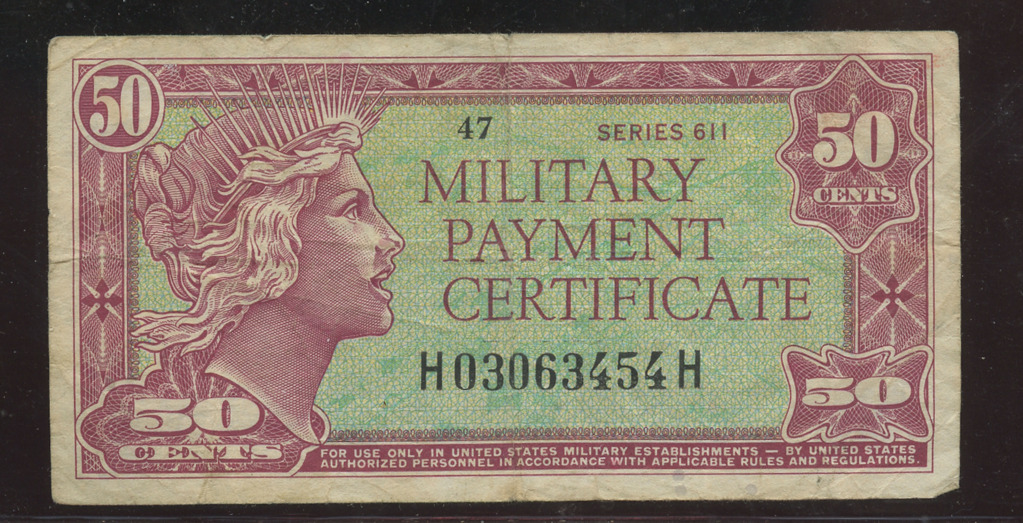MILITARY PAYMENT SERIIES 611 50C VF POSITION 47 , vendido en Agosto 2010, ¡Por 6.51 US$!
¿Cansado de perder subastas en el último segundo?
Date de alta en Keecua.com y consigue artículos como éste al mínimo precio gracias a las pujas de último segundo de Keecua.com, con Keecua.com conseguirás los mejores precios en eBay y evitarás subastas fraudulentas.
Seller assumes all responsibility for this listing.Item specificsCirculated/Uncirculated: Circulated
Here is a note of historic implications. A grand piece of nostolgic American artwork worthy of any military museum. Could be the superstar attraction at MPC fest. The opportunity of a lifetime.
Military Payment Certificates, or MPC, were used from the end of World War II until the end of the Vietnam War, between the years 1946 and 1973. MPC's utilized layers of line lithography to create colorful banknotes that could be produced cheaply. Fifteen series of MPC's were created but only 13 series were issued.
History of MPC
Military Payment Certificates (MPC) evolved from Allied Military Currency as a response to the large amounts of US Dollars circulated by American servicemen in post-World War II Europe. The local citizens might not trust local currencies as the future of their governments was unclear. Preferring a stable currency like U.S. dollars, local civilians often accepted payment in dollars for less than the accepted conversion rates. US Dollars became more favorable to hold, inflating the local currencies and thwarting plans to stabilize the local economy. Contributing to this problem was the fact that troops were being paid in dollars, which they could convert unlimited amounts to the local currency with merchants at the floating (black market) conversion rate, which was much more favorable to the GIs than the government fixed conversion rate. From this conversion rate imbalance, a black market developed where the servicemen could profit from the more favorable exchange rate.
To reduce profiteering from currency arbitrage, the US military devised the MPC program. MPCs were paper money denominated in amounts of 5 cents, 10 cents, 25 cents, 50 cents, 1 dollar, 5 dollars, 10 dollars, and starting in 1968 20 dollars. MPCs were fully convertible to US dollars upon leaving a designated MPC zone and convertible to local currencies when going on leave (but not vice-versa), and were illegal for unauthorized personnel to possess, thus, in theory, eliminating US dollars from local economies. Although actual greenbacks were not circulating, many local merchants accepted MPC on par with US dollars, as they knew they could use them on the black market. This was especially evident during the Vietnam War when the MPC program was at its zenith. To prevent MPC from being used as a primary currency in the host country, thereby destroying the local currency value and economy, MPC banknote style would change. Many veterans can recount a conversion day or C-Day.
C-days in Vietnam were always classified, never pre-announced. On C-day, soldiers would be restricted to base, preventing GIs from helping Vietnamese civilians--especially local bars, brothels, bar girls and other black market people--from converting old MPC to the newer style MPC. Since Vietnamese were not allowed to convert and frequently lost savings by holding old worthless MPC, they would be very angry about their MPC loss and "arrange" to have the nearest U.S. base rocketed or mortared the next night.
To illustrate the Vietnam war MPC cycle, in mid 1970, a GI could have a friend in the states mail him a U.S. $100 bill, take it "downtown" and convert it to 180 dollars MPC, then change MPC to South Vietnamese piastres at double the legal rate. The soldier could then have a fun day shopping, bar hopping, or a full service massage, paying in low cost local currency, and finishing the day with a hefty profit.
To continue the MPC cycle, that 100 dollar greenback would find its way to high level Vietnamese government officials, especially the corrupt ones, who had access to out of country travel, where the U.S currency could be deposited safely (Bangkok, Taipei, or Hong Kong). Rumors also suggested that this hard currency (U.S. dollars), would find its way to Europe, and then Hanoi.
Thirteen series of MPC were issued between 1946 and 1973, with varied designs often compared to Monopoly money due to their colors. After the Vietnam War MPC was never again issued, and the concept lay dormant until the late '90s when it was replaced by a Stored Value Card system, presently used by U.S. armed forces in Iraq.




